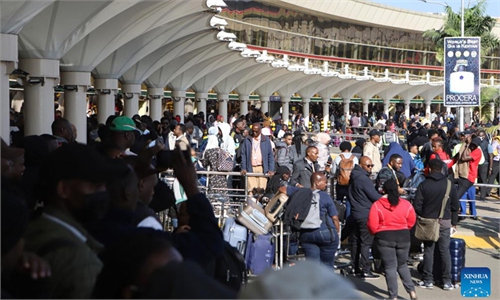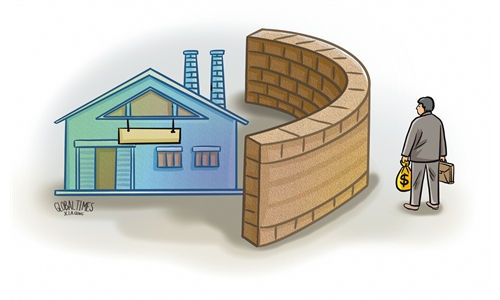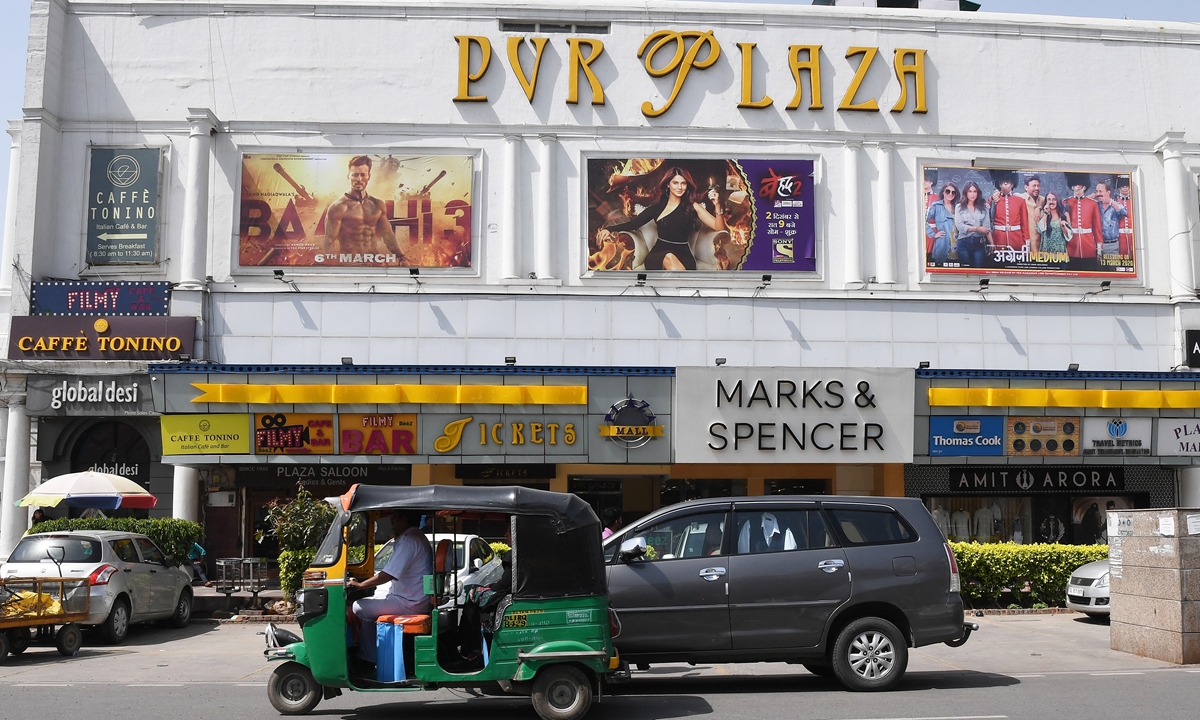
Vehicles drive past a closed PVR Plaza cinema complex in New Delhi, India. Photo: AFP
Editor’s Note:
Located in South Asia, India is China’s close neighbor, yet for many Chinese people, the country remains both intriguing and unfamiliar. Many social media bloggers often share various “incredible” experiences they encounter in India: Asia’s largest slum, the daring and reckless act of “train surfing,” and the “clean and hygienic” street food specialties, among others. While the lively streets and aroma of curry represent a unique side of Indian culture, Mi (pseudonym), a Chinese woman who has lived in India for nearly 20 years, has witnessed more of the country’s changes and its complex “duality.” The Global Times invites Mi to share her perspective on India with our readers.
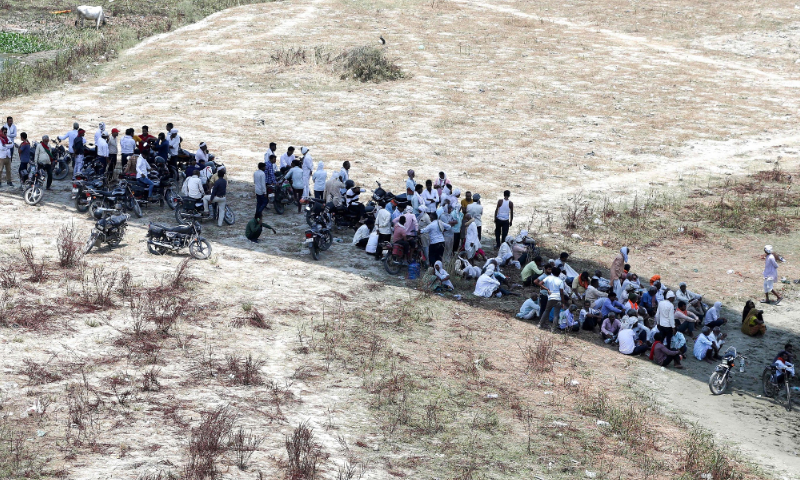
People take rest under the shade of a bridge to shelter from the scorching sun on a hot summer day along the banks of river Ganges in Prayagraj, India on June 3, 2024. Photo: VCG
Bumpy roads
Our impression of a strange city often begins at the airport or train station. In 2006, I flew directly from Beijing to New Delhi, the capital of India. As soon as I got off the plane, I was hit by a strong sensory overload: the complex aroma of spices filled the air; the customs officer’s accent made it hard for me to tell whether he was speaking Hindi or Indian English, no matter how carefully I listened; a little sunlight filtered through the thick grease on the glass windows, making it difficult to discern whether it was sunny or cloudy outside.
However, the situation quickly improved. In 2010, the opening of the new Terminal 3 at Indira Gandhi International Airport made it one of the largest and most important airports in South Asia, and it ranked among the world's largest modern airports. The airport's design is rich in elements of India's diverse culture, leaving a deep impression on travelers from all over the world.
When it comes to transportation in India, most people might think of trains packed with passengers. However, the subways and light rail systems in Indian cities are also clean, quiet, and well-equipped, with dedicated compartments for women. Riding the Indian subway in the summer is indeed a pleasant experience: the air conditioning is sufficient, the cars are bright and clean, and some stations even have cafes and convenience stores.
According to a report by Indian media outlet Mint, India’s Union Minister Hardeep Singh Puri said, “Today we have 945 kilometers of metro system functioning in the country, and we have another 1,000 under construction. This will be done in the next two and a half years, and we will have the world's second-largest urban transport metro.”
However, above this rapidly expanding subway network, the streets are a chaotic mix of cars, motorcycles, auto-rickshaws, and pedestrians, often encountering cows, dogs, camels, horse-drawn carts, and elephants. The sound of honking horns and bustling crowds is ever-present. As for highways, India has had them for 20 years, but this "high-speed" is not the same as what one might expect.
In 2006, when a group of us traveled to the Taj Mahal in Uttar Pradesh, I fell asleep as soon as I got in the car. After about an hour, I woke up to see cows, dogs, camels, tractors, and pedestrians still crossing the road, and I asked, “Why haven't we gotten on the highway yet?” Other passengers burst into laughter, saying, "This is the highway!"
Now, India finally has a real expressway. Known as the "Golden Quadrilateral," a network of four national highways that connects New Delhi, Mumbai, Kolkata, and Chennai, spanning approximately 5,800 kilometers. The travel time for the route from New Delhi to the Taj Mahal, which is about 200 kilometers, has been reduced from 5 hours to just 3 hours, with a toll fee of 470 rupees ($5.6).
Looking back 20 years ago, New Delhi had only one relatively decent shopping mall called Ansal Plaza, which was a two-story building. The more upscale shopping street was Connaught Place in the city center, built by former British colonizers. At its center is a circular large park surrounded by white buildings, all two stories high, housing shops, restaurants, cafes, and more. For most people, however, community markets were the preferred shopping destinations. Along a street, there were single-story shops on both sides, which looked like abandoned warehouses from the outside, and the interior arrangements were chaotic and cramped.
Things have improved significantly now. Large shopping malls, supermarkets, and convenience stores are everywhere in New Delhi, and people’s lives have benefited from better infrastructure. However, the situation of pothole-ridden streets and litter-strewn areas in Indian cities have not changed. An Indian friend joked that in India, even if you drive a million-dollar luxury car, you still are forced to experience the bumps. I recall that just before the local elections, the streets in my community were hastily repaired. Although they looked new, the quality of the construction was concerning, and not long after the elections, they returned to their original state. The locals lamented to me, "the government won't make investments without returns."
It wasn't until the 2010 Commonwealth Games and last year’s Group of 20 (G20) Summit that the relevant main roads and supporting facilities received a much needed attention, but there were issues with the quality of the work. The overpass outside the Nehru Stadium, which was upgraded, collapsed just half a month before the opening of the Games in 2010. In June, the roof of Terminal 1 at the airport also collapsed due to heavy rain. As soon as the rainy season arrives, the underground passages get flooded, making it impossible to find the entrances.
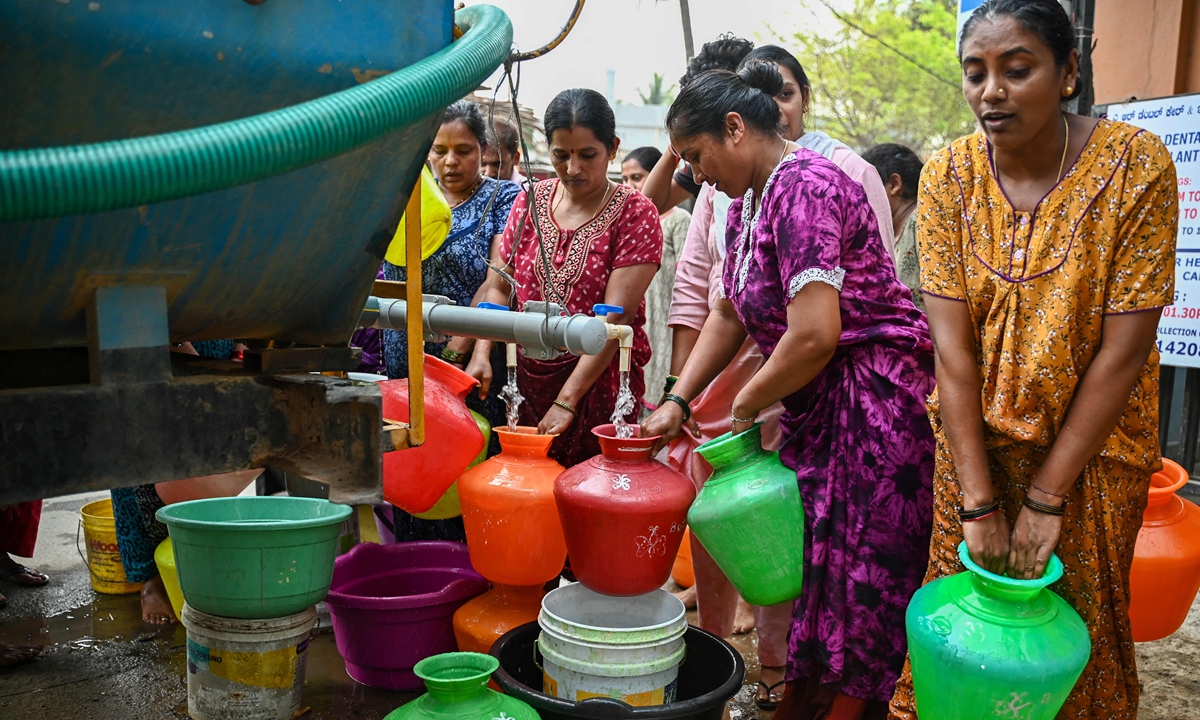
Residents collect free water from a municipal tanker amid the ongoing water crisis in Bengaluru on March 15, 2024. The “Silicon Valley” of India is facing severe water scarcity amid its worst drought in 30-40 years. Reports said more than 3,000 bore wells across the city have dried up. Photo: VCG
Spiritual gap
My first visit to India was to attend my boyfriend's sister's wedding, which felt like a fairy tale. However, the stark contrast between the opulence of the wedding and the dirty, pothole-filled streets made it difficult for me to form a coherent impression of this place. The guests were adorned in dazzling jewelry while beggars tapped on car windows with their faces etched with hunger; the robust guests clinked glasses while the frail rickshaw pullers sweated profusely. I passed by makeshift shanties with roofs barely waist high. The biggest psychological challenge for me in India was constantly absorbing the jarring impact of these disjointed scenes.
Upon first encountering India, one cannot help but notice its sense of ritual: the devotion to religious beliefs as part of a “slow life,” and the warmth of younger generations performing the foot-touching gesture for their elders. I used to think that "slow living" was a "patent" of developed countries, which often left me puzzled: why does India, with around 200 million people living in poverty, not have a sense of urgency? After living in India for a few years, I gradually came to understand their underlying logic: they believe that "life is just a fragment of the soul's journey, and ordinary people have no need to rush. What matters is to attain spiritual elevation through devotion.”
India is known not only for its significant wealth gap, but also for the low social and familial status of women, particularly in rural areas and among the lower classes in urban centers. Many women face early marriage, early childbirth, and abuse from in-laws due to insufficient dowries. One of my middle-aged Indian female friends complained that her father had never held her but always embraced her brother. When she was born, her father was in Mumbai for business; after booking a return flight, he changed his mind and canceled the ticket upon hearing that he had a daughter.
In middle-class Indian families, it is common to employ domestic helpers. A live-in maid typically earns around 1,500 yuan ($212) per month, while a non-live-in maid earns less than 1,000 yuan per month. They never sit on chairs but instead sit on the floor, and they have special iron plates and bowls for eating. Non-live-in maids are allowed to take home leftover food and sometimes even take away old clothes that their employers no longer wear.
In the past, women's development in India was often constrained by traditional roles. At home, they followed their fathers, and after marriage, they followed their husbands. Even today, it is still quite common for Indian girls to take their husband’s surname after marriage, and some traditional in-laws even change the girl’s name, referring to it as “starting a new life."
Nowadays, most middle-class families in India care for their daughters. Young urban parents are not like the previous generation who only preferred boys to girls, and women's opportunities for development have greatly expanded. For example, my Indian female friends have received a good education, speak fluent English, and work in fields they are passionate about. One girl was a physiotherapist before marriage and later opened a clinic, hiring someone to manage it while she teaches as a guest lecturer twice a week. However, this relatively comfortable and pleasant life after marriage is heavily reliant on financial support from her family.
In addition to the status of women, the caste system is another relic of feudal society in India that has been widely criticized. Although the constitution has long abolished it, the influence of caste in society today remains significant. After living with Indians for many years, I have come to realize the deep spiritual divide that the millennia-old caste system has created among people. Compared to the gap between the rich and the poor, this spiritual barrier is even harder to overcome.
What surprised me the most is that in public places, high-caste individuals often give orders to low-caste individuals whom they do not know, and the latter tend to accept this treatment submissively. For example, when a rickshaw or a small vendor's cart is parked in the market, if a car wants to stop in that spot, the driver will simply honk the horn to demand that the other person move. Children mimic this behavior as well. High-caste children in parks never play with low-caste children. Furthermore, if a high-caste girl falls in love with or marries a low-caste man, her brothers and father may act in the name of "protecting family honor," effectively ostracizing her.
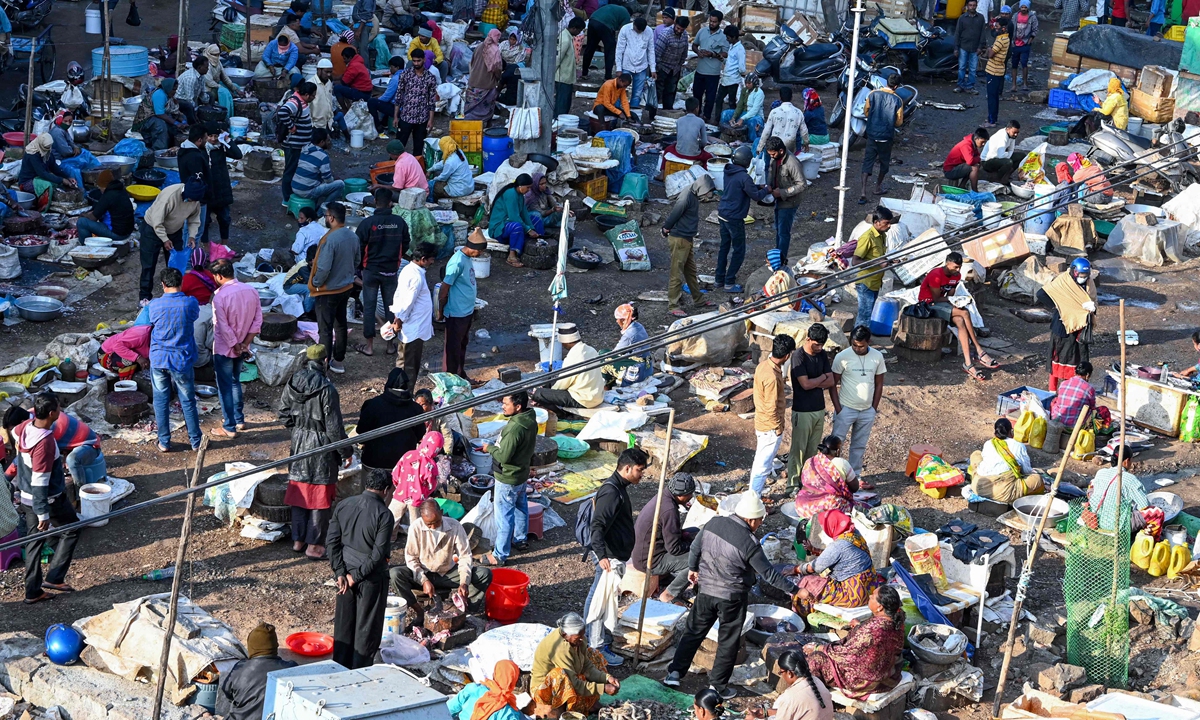
People buy fish at a wholesale fish market in Hyderabad, India, on November 21, 2022, a day which is also marked as World Fisheries Day. World Fisheries Day is celebrated on November 21 every year to demonstrate solidarity with all fisher folk, fish farmers and concerned stakeholders throughout the world. Photo: VCG
Two camps
India's “dual characters” is also reflected in its contradictory attitude toward foreign investment. On one hand, India has implemented large-scale measures to attract foreign investment. On the other hand, officials are paranoid that foreign companies will seize the domestic market, leading to strong support for Indian enterprises. This has resulted in a deteriorating business environment and increasing difficulties in attracting foreign investment.
For instance, the American fast-food chain Burger King sued an Indian restaurant with the same name for trademark infringement, and after a 13-year legal battle, it ultimately lost the case. The reason was that the Indian Burger King had been using the trademark since 1991, before the American Burger King entered the Indian market. An Indian friend jokingly remarked to me, "It's just too bad that the American Burger King came to India too late!" Additionally, some of my Chinese friends have been forced to abandon their operating factories in India in recent years due to difficulties in obtaining visas.
When I first got married, it was rare to see Chinese faces in India. My Chinese friend Xiao He, who married her Indian husband in 2004, even had their wedding featured in an Indian newspaper. 10 years ago, with the arrival of Chinese companies like OPPO and Xiaomi, as well as the increase in trade between the two countries leading to more cross-national marriages, the Chinese community in India began to grow. We gradually formed our own community, celebrating traditional festivals together, spreading Chinese culture, and promoting people-to-people exchanges between the two countries.
Taking our family as an example, under my guidance, we moved our dinner time from 9:30 pm to before 8 pm, which helped my originally overweight in-laws lose 20 kilograms. Our whole family also started drinking Tieguanyin tea with me, gradually changing their habits of drinking ice water and taking cold showers.
Overall, most of the Indians I encounter in daily life are friendly and open. I also know quite a few who have been to China or have trade relations with China. In their eyes, Yiwu and Guangzhou are the "most famous" cities in China, and some have also visited Shanghai. The trade they engage in mostly involves importing electrical appliances, shoes, hats, toys among others from China.
Indian businessman Delneja took over the wholesale shoe business from his father 20 years ago and used to travel to Yiwu for procurement multiple times when he was younger. A few years ago, he happily showed me an application on his phone, telling me that now he only needs to confirm new products with Yiwu merchants on WeChat to directly place orders, eliminating the need to travel to China every time for procurement. "It saves on travel expenses, platform commissions, and makes the products more competitively priced," he said.
Some better schools in India advocate for respect for cultural diversity and often organize performances where students showcase various cultures through songs, dances, and dramas, with Chinese elements often being a key part. At first, the Chinese couplets on stage looked quite perplexed as they were randomly drawn by Indian teachers and parents. Later, I took the initiative to join the props team, helping the children prepare couplets, paper cuttings, Chinese knots, lanterns, and other props and decorations.
In these small acts of mutual help and communication, I feel that the people of China and India can better understand and respect each other. The "invisible barriers" between individuals seem to loosen, allowing beams of light to shine through.

